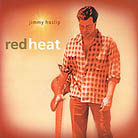August 2000
Besides his favored Mike Tobias fretless bass and various five-, six- and eight-string fretted acoustical and electrical basses and their synth derivatives, Haslip’s also authentically adept at playing Latin percussion. His familiarity with claves, maracas, cowbell, bongos and guido as well as his understanding of the concomitant complexity that’s hardwired into Cuban and Latin music styles might help to explain his unerring sense of pace and rhythm. It’s the tight glue that forms the foundation for any successful groove and ensemble, and his new album is groovy in the best sense of the well-worn Woodstock word. We’re looking here at a solo effort on the Encino-based Unitone label, with main collaborator Joe Vannelli co-authoring seven of the ten original tunes and supporting the quiet storm with keyboards, synth bass and drum programming. The always dense and very textured rhythm section includes old timer Luis Conte and Mike Shapiro. Reed monster Steve Tavaglione foregoes his usually mean and virtuoso flute for tenor and soprano sax and makes an appearance on two tracks. Tracks like "El Calor," "El Sol Colorado" and "Fuego" -- heat, sun, fire -- prepare the jacket reader for adrenaline-injected outings replete with Cuban-style brass riffs and Salsa-tinged vocals. However, there’s plenty of room left for lyrical excursions into instrumental "Luther Vandross territory" and grittier but Earl Klugh-reminiscent moods. This album is very much the work of an experienced and sophisticated musician beyond nervous concerns over chops. At first, the perfectly logical -- logical once you consider a bit of history -- laissez-faire ease of delivery could overlook the subtleties and wealth of details and outright craftiness that pervades these tunes. Hooks, wordless parallel vocalizing with one’s instrument and syncopated brass accents are all-too-common jazz-pop ingredients. Their presence allows the casual listener to slip into these tunes like a faded-out coat but overlook that it’s truly of the multi-colored, dimensional variety and thus far more complex than it lets on. As SoundStage! is a forum for music lovers and audiophiles, it’s fair to mention that the presence of a fast, tuneful and precise subwoofer without overhang but serious extension should nearly be considered mandatory. This will really capture every morsel of bass riffs and foundation patterns that are occurring just below the surface. I was lucky enough to have one in-house during this review and enjoyed the results immensely. Turning it off for a reality check brought home the sage advice that there’s often more on a recording than is apparent to the ear. It’s really amazing how downright enjoyable this entire album is even after multiple go-rounds. After all, every hothead can relate to and salivate over big-block engines. A tractor-speed duel is more incongruous. Ditto for a ten-course serving of bass guitar "solo" tunes. Well, hold it there now and account for the glowing exceptions to fast and ready statements. Red Heat succeeds to capture and hold your attention even if, like me listener, you’re not a dyed-in-the-wool bass hound, groove hipster or fretless sophisticate. I’m glad that this Unitone release landed on my review pile and not somebody else’s. Recommended. GO BACK TO: |
 Jimmy Haslip - Red Heat
Jimmy Haslip - Red Heat![[Reviewed on CD]](../format/regcd.gif) Jimmy Haslip’s stated influences range from Tito Puente and Mongo
Santamaria to John Coltrane and Charlie Parker, not to mention Debussy and Stravinsky,
Mozart and Mahler, Béla Bartók and Oliver Messiaen. The list continues, but it’s
clear that the Yellowjacket’s bass player culls from an enormously broad musical
field of inspiration. Though predominantly self-taught, Haslip fondly recounts a few weeks
of personal studies with Jaco Pastorious after Pastorious had just joined Weather Report
in the mid '70s. Yet it was seeing Jimi Hendrix perform live that proved to be the
inspiration that committed the young aspiring artist to pursue music as a full-time
career.
Jimmy Haslip’s stated influences range from Tito Puente and Mongo
Santamaria to John Coltrane and Charlie Parker, not to mention Debussy and Stravinsky,
Mozart and Mahler, Béla Bartók and Oliver Messiaen. The list continues, but it’s
clear that the Yellowjacket’s bass player culls from an enormously broad musical
field of inspiration. Though predominantly self-taught, Haslip fondly recounts a few weeks
of personal studies with Jaco Pastorious after Pastorious had just joined Weather Report
in the mid '70s. Yet it was seeing Jimi Hendrix perform live that proved to be the
inspiration that committed the young aspiring artist to pursue music as a full-time
career.